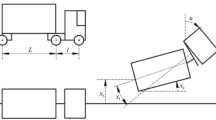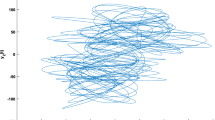Abstract
This paper deals with the unknown input observer design for Takagi-Sugeno (T-S) fuzzy models subjected to measurement noise and stochastic noise. The method applies the singular system theory by considering the measurement noise as an augmented system state, and then an unknown input observer based on the techniques of singular systems is developed to estimate both the system states and measurement noise simultaneously. Under a necessary assumption, the error dynamic system of the observer is free from the unknown inputs. And the observer gain matrix is determined by means of minimum covariance matrix of state residual. Two simulation examples are given to illustrate the correctness and effectiveness of the proposed method.
Similar content being viewed by others
References
M. Darouach, M. Zasadzinski, and S. J. Xu, “Fullorder observers for linear systems with unknown inputs,” IEEE Trans. on Automatic Control, vol. 39, no. 3, pp. 606–609, 1994.
Y. Guan and M. Saif, “A novel approach to the design of unknown input observers,” IEEE Trans. on Automatic Control, vol. 36, no. 5, pp. 632–635, 1991.
T. Floquet and J. P. Barbot, “State and unknown input estimation for linear discrete-time systems,” Automatica, vol. 42, no. 11, pp. 1883–1889, 2006.
Z. Wang, Y. Shen, and X. Zhang, “Actuator fault estimation for a class of nonlinear descriptor systems,” International Journal of Systems Science, vol. 45, no. 3, pp. 487–496, 2014.
T. Fernando, S. MacDougall, V. Sreeram, and H. Trinh, “Existence conditions for unknown input functional observers,” International Journal of Control, vol. 86, no. 1, pp. 22–28, 2013.
T. G. Park, “Designing fault detection observers for linear systems with mismatched unknown inputs,” Journal of Process Control, vol. 23, no. 8, pp. 1185–1196, 2013.
B. Kulcsár, J. Bokor, and J. Shinar, “Unknown input reconstruction for LPV systems,” International Journal of Robust and Nonlinear Control, vol. 20, no. 5, pp. 579–595, 2010.
K. C. Veluvolu and Y. C. Soh, “Discrete-time sliding-mode state and unknown input estimations for nonlinear systems,” IEEE Trans. on Industrial Electronics, vol. 56, no. 9, pp. 3443–3452, 2009.
M. E. Valcher, “State observers for discrete-time linear systems with unknown inputs,” IEEE Trans. on Automatic Control, vol. 44, no. 2, pp. 397–401, 1999.
F. Zhu, “State estimation and unknown input reconstruction via both reduced-order and high-order sliding mode observers,” Journal of Process Control, vol. 22, no. 1, pp. 296–302, 2012.
S. Ahmadizadeh, J. Zarei, and H. R. Karimi, “Robust unknown input observer design for linear uncertain time delay systems with application to fault detection,” Asian Journal of Control, vol. 16, no. 4, pp. 1006–1019, 2014.
S. Ahmadizadeh, J. Zarei, and H. R. Karimi, “Robust fault detection of linear uncertain time-delay systems using unknown input observers,” Journal of Applied Mathematics, vol. 2013, Article ID 829715, p. 12, 2013.
K. Kalsi, J. Lian, S. Hui, and S. H. Żak, “Slidingmode observers for systems with unknown inputs: a high-gain approach,” Automatica, vol. 46, no. 2, pp. 347–353, 2010.
M. Hou and P. C. Muller, “Design of observers for linear systems with unknown inputs,” IEEE Trans. on Automatic Control, vol. 37, no. 6, pp. 871–875, 1992.
W. Chen and M. Saif, “Unknown input observer design for a class of nonlinear systems: an LMI approach,” Proc. of the IEEE American Control Conference, pp. 834–838, 2006.
D. Koenig and S. Mammar, “Design of proportional-integral observer for unknown input descriptor systems,” IEEE Trans. on Automatic Control, vol. 47, no. 12, pp. 2057–2062, 2002.
T. Takagi and M. Sugeno, “Fuzzy identification of systems and its applications to modeling and control,” IEEE Trans. on Systems, Man and Cybernetics, vol. 15, no. 1, pp. 116–132, 1985.
H. R. Karimi and M. Chadli, “Robust observer design for Takagi-Sugeno fuzzy systems with mixed neutral and discrete delays and unknown inputs,” Mathematical Problems in Engineering, vol. 2012, Article ID 635709, p. 13, 2012.
K. Z. Ghafoor, K. Abu Bakar,_S. Salleh, K. C. Lee, M. M. Mohamad, M. Kamat, and M. Md Arshad, “Fuzzy logic-assisted geographical routing over vehicular Ad Hoc networks,” International Journal of Innovative Computing Information and Control B, vol. 8, no. 7, pp. 5095–5120, 2012.
J. Yang and J. Watada, “Fuzzy clustering analysis of data mining: application to an accident mining system,” International Journal of Innovative Computing Information and Control, vol. 8, no. 8, pp. 5715–5724, 2012.
J. Botzheim and P. Foldesi, “Parametric approximation of fuzzy exponent for computationally intensive problems,” International Journal of Innovative Computing Information and Control, vol. 8, no. 8, pp. 5725–5744, 2012.
X. P. Guan and C. L. Chen, “Delay-dependent guaranteed cost control for TS fuzzy systems with time delays,” IEEE Trans. on Fuzzy Systems, vol. 12, no. 2, pp. 236–249, 2004.
J. Joh, Y. H. Chen, and R. Langari, “On the stability issues of linear Takagi-Sugeno fuzzy models,” IEEE Trans. on Fuzzy Systems, vol. 6, no. 3, pp. 402–410, 1998.
P. Bergsten, R. Palm, and D. Driankov, “Observers for Takagi-Sugeno fuzzy systems,” IEEE Trans. on Systems, Man, and Cybernetics, Part B: Cybernetics, vol. 32, no. 1, pp. 114–121, 2002.
X. Jiang, Q. L. Han, and X. Yu, “Robust H ∞ control for uncertain Takagi-Sugeno fuzzy systems with interval time-varying delay,” Proc. of the IEEE American Control Conference, pp. 1114–1119, 2005.
X. Liu and Q. Zhang, “New approaches to H ∞ controller designs based on fuzzy observers for TS fuzzy systems via LMI,” Automatica, vol. 39, no. 9, pp. 1571–1582, 2003.
H. Zhang, Y. Shi, and A. S. Mehr, “On filtering for discrete-time Takagi-Sugeno fuzzy systems,” IEEE Trans. on Fuzzy Systems, vol. 20, no. 2, pp. 396–401, 2012.
K. Zhang, B. Jiang, and P. Shi, “Fault estimation observer design for discrete-time Takagi-Sugeno fuzzy systems based on piecewise Lyapunov functions,” IEEE Trans. on Fuzzy Systems, vol. 20, no. 1, pp. 192–200, 2012.
M. Bouattour, M. Chadli, M. Chaabane, and A. El Hajjaji, “Design of robust fault detection observer for Takagi-Sugeno models using the descriptor approach,” International Journal of Control, Automation and Systems, vol. 9, no. 5, pp. 973–979, 2011.
M. Chadli, A. Abdo, and X. D. Steven, “H−/H ∞ fault detection filter design for discrete-time Takagi-Sugeno fuzzy system,” Automatica, vol. 49, no. 7, pp. 1996–2005, 2013.
M. Chadli and H. R. Karimi, “Robust observer design for unknown inputs Takagi-Sugeno models,” IEEE Trans. on Fuzzy Systems, vol. 21, no. 1, pp. 158–164, 2013.
Z. Gao and D. W. Ho, “State/noise estimator for descriptor systems with application to sensor fault diagnosis,” IEEE Trans. on Signal Processing, vol. 54, no. 4, pp. 1316–1326, 2006.
Z. Gao and H. Wang, “Descriptor observer approaches for multivariable systems with measurement noises and application in fault detection and diagnosis,” Systems & Control Letters, vol. 55, no. 4, pp. 304–313, 2006.
D. J. Lee, Y. Park, and Y. S. Park, “Robust H ∞ sliding mode descriptor observer for fault and output disturbance estimation of uncertain systems,” IEEE Trans. on Automatic Control, vol. 57, no. 11, pp. 2928–2934, 2012.
Z. Hu, Y. Sun, B. Jiang, J. He, and C. Zhang, “An optimal unknown input observer based fault diagnosis method,” Acta Automatica Sinica, vol. 39, no. 8, pp. 1225–1230, 2013.
H. R. Karimi and H. Gao, “New delay-dependent exponential synchronization for uncertain neural networks with mixed time delays,” IEEE Trans. on Systems, Man, and Cybernetics, Part B: Cybernetics, vol. 40, no. 1, pp. 173–185, 2010.
Author information
Authors and Affiliations
Corresponding author
Additional information
Recommended by Associate Editor Choon Ki Ahn under the direction of Editor Euntai Kim.
This work was supported by the National Nature Science Foundation of China (61074009). This work is also supported by the Research Fund for the Doctoral Program of Higher Education of China (20110072110015), Guangxi Key Laboratory of Manufacturing System & Advanced Manufacturing Technology (PF110289), and Shanghai Leading Academic Discipline Project (B004).
Shenghui Guo received his M.S. degree from Hebei University of Technology, China, in 2009. He is currently pursuing a Ph.D. in Control Theory and Control Engineering in Tongji University, China. His research interests include observer design, model-based fault detection, and fault-tolerant control.
Fanglai Zhu received his Ph.D. degree in Control Theory and Control Engineering from Shanghai Jiao Tong University in 2001. Now he is a professor of Tongji University, China. His research interests include nonlinear observer design, chaotic synchronization based on observer, system identification, and model-based fault detection and isolation.
Liyun Xu received his Ph.D. degree from Shanghai Jiaotong University, China, in 2001, Postdoctor of Vienna University of Technology in 2005, and visiting scholar of Politecnico di Milano in 2010. He joined the faculty of Tongji University, and currently is an associate professor at the School of Mechanical Engineering. His research interests include system modelling and optimization, fault diagnosis, and intelligent manufacturing.
Rights and permissions
About this article
Cite this article
Guo, S., Zhu, F. & Xu, L. Unknown input observer design for Takagi-Sugeno fuzzy stochastic system. Int. J. Control Autom. Syst. 13, 1003–1009 (2015). https://doi.org/10.1007/s12555-014-0190-5
Received:
Revised:
Accepted:
Published:
Issue Date:
DOI: https://doi.org/10.1007/s12555-014-0190-5




